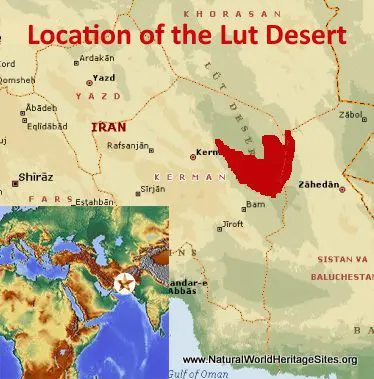EXPLORE the Lut Desert with this slideshow, check the location map and get all the facts and information below.
For slideshow description see right or scroll down (mobile). Click to view slideshow
Location and Values: The Lut Desert is a vast area of hot, hyper-arid desert lying in an interior basin surrounded by mountains in south-eastern Iran. It exhibits a rich variety of spectacular desert landforms, including the world’s best examples of Aeolian yardangs and huge sand seas with some of the world’s largest dunes. Yardangs are bedrock features carved by the sandblasting effects of strong winds, which are visible as parallel rows of huge eroded rocks, with corridors between them, aligned with the dominant prevailing wind. In addition to the yardangs and sand seas, about 12% of the desert is made up of stony desert pavements with salt-encrusted crystalline river beds, salt pans, crusts and gypsum domes. The region experiences the highest land temperatures anywhere on Earth, with an all-time high of 70.7OC recorded within the site.
Conservation Status and Prospects. According to IUCN’s Conservation Outlook Assessment (2020) the conservation status of the Lut Desert is ‘good’. The IUCN report notes that the desert’s vast extent and harsh environment provides a high degree of natural protection to most of the site, although areas close to settlements on the desert margins are subject to pressures from livestock grazing and firewood collection. This is resulting in accelerated desertification and destruction of some of the dunes which form around plants (known as nebkhas) in these areas. There are growing pressures from tourism, and the development of tourist infrastructure, roads and off-road traffic are considered to be the main threats requiring management attention.
Links:
Google Earth
Official UNESCO Site Details
IUCN Conservation Outlook
UNEP-WCMC Site Description
Slideshow description
The slideshow ‘tells the story’ of the Lut Desert with a portfolio of photos that illustrate its spectacular landscapes and geological features. It covers a great variety of the desert landforms that characterize the Lut Desert, with its vast rock outcrops, active dune fields, nebkhas (dunes that form around plants), palm-filled oases, yardangs (massive corrugated ridges of wind-blasted rock), stony desert pavements, salt pans and crystalline river beds.
The following Flickr photographers are acknowledged with thanks for their contributions to this slideshow (as credited in the watermark of each photo): Anon, akcfoto, Gaetan Dalle, L’Oranger, Mark, Marsel van Oosten, Ninara, Pascal Chx, Samuel Sieder, Sergi Hill, Teun Janssen and Vic Nomad.
Factfile
Website Category:
Desert
Area: 22,780 km2
Inscribed: 2016
UNESCO Criteria:
- Exceptional natural phenomenon (vii);
- Outstanding natural beauty (vii);
- Geological features (viii);





